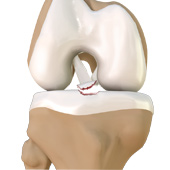What are Tibial Eminence Fractures?
The tibial eminence, also called the tibial spine, is a bony protuberance of the tibia (shin bone) that attaches to the anterior cruciate ligament (ACL) of the knee joint.

A tibial eminence fracture is break or crack in the bony attachment of the ACL to the tibia. The fracture can be a contact or non-contact injury and occurs at the base of the tibial eminence.
Overview
The tibia is a long, weight-bearing bone forming the front part of your leg from the knee to ankle. It is the larger and stronger of the two bones in the leg below the knee (the other thinner one being the fibula or calf bone). The tibia forms the shin with its top connecting to the knee joint and its bottom to the ankle joint.
The ACL is one of a pair of ligaments in your knee. It connects the bottom of the femur (thighbone) to the top of the tibia. The point of attachment is the tibial eminence, and it functions to prevent the tibia from sliding out in front of the femur.
Who is at Risk?
Tibial eminence fractures may occur at any age but are more common among:
- Children aged between 8-14 (skeletally immature persons)
- Adolescent girls
The condition is rarely seen in adults.
Etiology
Typically, a tibial eminence fracture is the result of direct trauma and high amounts of pressure on the ACL, leading to an avulsion (tearing away) at the tibial eminence. The condition can be caused by any of the following:
- A fall from bicycle
- Sports or athletic activities
- Motor vehicle accidents
- Knee twisting
Signs or Symptoms
The major signs or symptoms of tibial eminence fractures include:
- Severe swelling and pain in the knee
- Failure to fully extend the knee
- Inability to bear weight while walking
- Painful hemarthrosis (bleeding into a joint)
If Left Untreated
If left untreated, tibial eminence fractures may result in a severe stiffness of the knee (arthrofibrosis) and reduced range of motion.
Diagnosis
Your doctor will begin the diagnosis with the evaluation of your medical history, followed by a thorough physical examination which may require X-ray, CT scan or MRI images to confirm the condition.
Treatment
Treatment of tibial eminence fractures usually involves realigning or repositioning the tibial eminence bone. Your doctor will decide on the appropriate treatment option depending on the severity of the fracture.
Nondisplaced fractures (where the bone is split but the fragments remain aligned)
Minimally displaced fractures (where the broken ends of the bone line up almost perfectly, and stay in place during healing)
These are treated non-operatively and managed conservatively with:
- Casting or bracing
- Immobilization followed by physical therapy
In the case of displacement or severe displacement where the bone has significantly shifted, surgery may be indicated.
The doctor may choose either open reduction and fixation (with sutures or screws) or arthroscopic fixation, depending on the situation. Arthroscopy is generally favored, with better long-term results. Surgery places the bone tissue back into the correct anatomical position and may preserve the ACL.
Regardless of the extent of the injury, aggressive rehabilitation is key for a full recovery. Early detection and management of tibial eminence fractures can reduce morbidity and minimize long-term complications.












